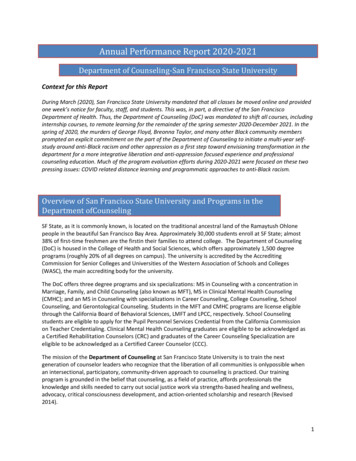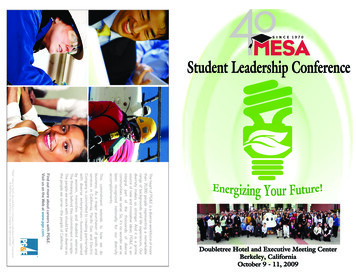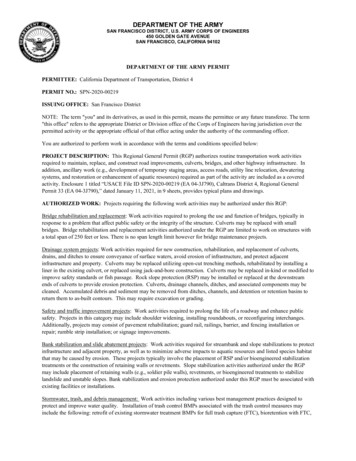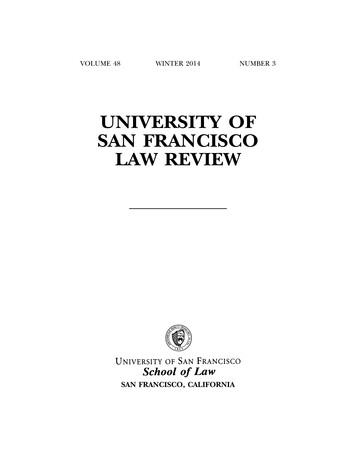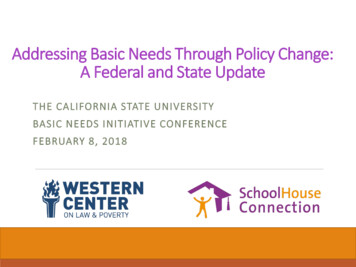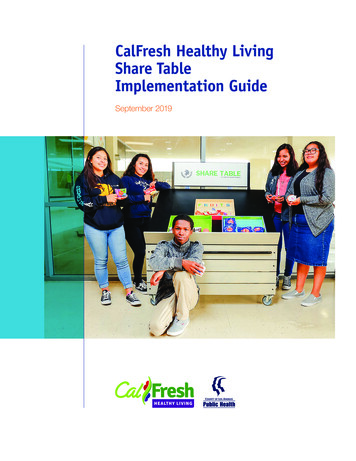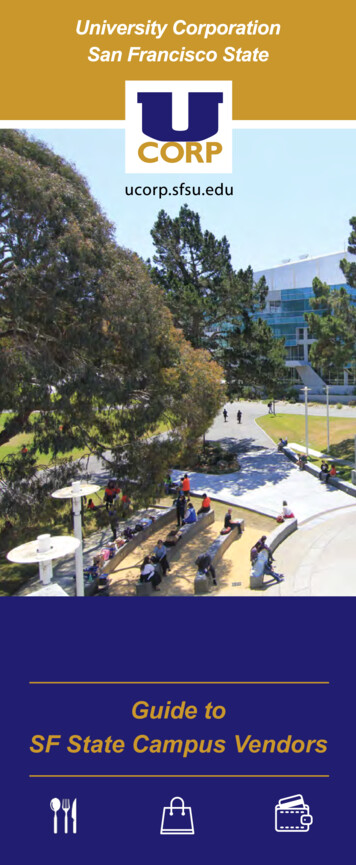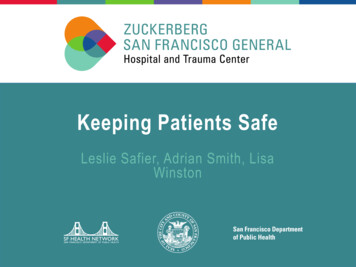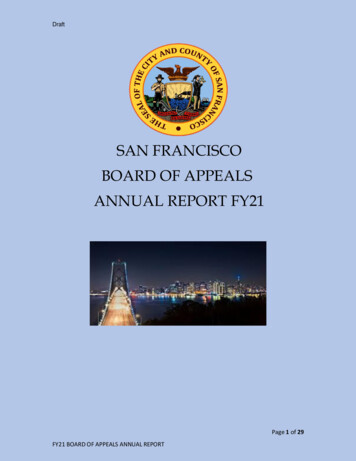
Transcription
San Francisco State UniversityCalFresh Help ClinicProgram ReportFall 2018- Spring 2020Program SummaryAccess to quality food is essential for students to reach their full potential at San FranciscoState University. In 2018, 47% of San Francisco State students surveyed reportedexperiencing food insecurity. Students who lack the resources necessary to obtain food on aregular basis are at heighten risk for negative physical and mental health outcomes, andexperience lower academic achievement (Crutchfield & McGuire, 2018). In 2018, SF Statereceived grant funding from the CSU Chico Center for Healthy Communities to establish aCalFresh assistance program on campus. CalFresh is a federally funded nutrition programthat provides qualified low-income households with benefits to purchase food. The SF StateCalFresh Help Clinic (CFHC) launched in October 2018 as part of a larger Basic NeedsInitiative. The CFHC aimed to support student achievement and improve health outcomesby increasing food access, destigmatizing and normalizing services, assisting students withobtaining benefits and connecting students with other campus food access and nutritionprograms. Trained student volunteers and paid student assistants supported CalFreshoutreach, education, eligibility screening and application assistance. These CalFresh NaviGators provided drop-in assistance four days a week at the CFHC as well as communityweekly outreach and assistance at the AS Food Pantry and Farmers Market. Additionally,large-scale campus events were implemented each semester in alignment with nationalawareness days.
Program OutcomesFrom October 2018 to May 2020, the CalFresh Help Clinic directly served 645 students,while CalFresh outreach supported the initiation of 2,014 SF State CalFresh applications. In2019, 383 SF State students were approved for benefits, providing up to 192 each monthto purchase food and groceries. Over the course of four semesters, forty-two studentCalFresh assisters were trained, providing professional development, leadershipopportunities and direct-service experience. Following campus-wide promotion and culturechange-work to normalize CalFresh, the total number of students served increased nearlyseven times when compared to the previous year. The CFHC worked with campus partnersto provide focused services to students at heightened high risk for food insecurity includingfirst-generation college students and former foster care youth. Due to COVID-19, CalFreshservices moved to virtual modalities in early March, 2020. Sixty-one students accessedservices via email, phone and Zoom appointments. Additionally, outreach to supportstudents who applied for CalFresh on their own was intensified. April 2020 marked a montheconomically stifled by City and State Shelter in Place orders. There was a 205% increase inSF State CalFresh applications in April 2020 when compared to the previous year, indicatingduring times of uncertainty and financial crisis students rely on the University to connectthem to meaningful resources.Table: CalFresh Assistance Oct 2018- May 72721766451326566355912,014TBDTBDStudents ServedDirect service- CalFresh screening, applicationassistance and other supportOnline applications receivedDirect and indirect service- Includes students whodid not utilize in-person CalFresh assistance.Applications ApprovedApplication approved by the student’s County.UNK383*In-person CalFresh services were halted on 3/10/2020 due to COVID-19 precautions. CalFresh assistance moveto remote modalities for the remainder of the semester, 61 students were served virtually post COVID shut down.
Best Practices and Lessons LearnedA peer-to-peer staffing model increased service capacity and provided student leadershipopportunity- Involving student leaders in the staffing and operations of the program, manyof whom were CalFresh recipients, expanded the frequency and quality of CalFreshassistance and community outreach, while also providing an opportunity for studentgrowth, experience and professional development. Student staff were trained using culturalhumility, health equity and anti-stigma frameworks.CalFresh outreach is a means to connect students to other food access programs- When astudent was served at the CalFresh Help Clinic or community outreach tables, they werealso provided information about all other free food resources on campus.Partnerships with local Food Banks are essential to success- Local food banks often have alegacy of working with their County to support CalFresh enrollment. The SF-Marin FoodBank provided the CFHC with critical program support including interpreting CalFresh policychanges, providing frameworks and best practices, advocating on behalf of students to theCounty, providing trainings and skill building and serving as a liaison between SF State andthe County to bring Eligibility Workers to campus for CalFresh enrollment events.Working with campus partners is essential to reach high-need students- The CalFresh HelpClinic collaborated with Associated Students to provide CalFresh assistance weekly at the ASFood Pantry and Farmers Market. Additionally, the CFHC collaborated with GuardianScholars program and EOP to reach first generation students and former foster care youth.
CalFresh outreach is visibility work that normalizes and destigmatizes accessing foodresources – Providing weekly tabling at the AS Food Pantry, Farmers Market and quad,displaying marketing materials in offices around campus and promoting CalFresh on socialmedia and in newsletters, permeated campus awareness to normalize utilizing food accessprograms as acceptable and routine.Follow-ups are important- Though a student may be eligible, obtaining benefits does notoccur solely by submitting an application. The heavy-lift is submitting verificationdocuments and completing a County phone interview. After applying, it was important tofollow-up with students to ensure they had support retrieving student exemptionpaperwork and were able to interpret County paperwork.Organized data tracking is important- Tracking weekly outcomes from varying programlocations, e.g. drop-in hours vs. food pantry tabling, provided early insight on outcometrends, allowing for process program improvements.ChallengesServing students from multiple Counties- SF State is a commuter school, serving studentsfrom 7 surrounding Counties. Each of these Counties manages CalFresh independently. Itproved unrealistic to accomplish a magnitude of partnership building with all 7 Counties,making it difficult to maximize support for students who lived in a County with whom we didnot have a formal relationship.Constantly changing CalFresh policy and practices- CalFresh policies and practices are everevolving. Federal attacks on SNAP initiated harmful CalFresh policy changes, unannouncedpractice changes at the County level resulted in inconsistent approval and denials andCOVID-19 initiated an array of (mostly positive) program changes, all of which must becommunicated to CalFresh Assisters and recipients in a comprehendible and timely manner.
Moving ForwardReflecting on the establishment and expansion of the CalFresh Help Clinic, the SF State BasicNeeds Initiatives takes pride in the exponential growth of students served and trained. Aswe look toward the next phase of this program, we hope to increase the number ofstudents who successfully obtain CalFresh benefits, connect CalFresh students to robustnutrition education programs, as well as expand campus outreach and awareness.ReferencesCrutchfield, R., & McGuire, J. (2018, January). Study of Student Basic Needs. California StateUniversity.For more information please email basicneeds@sfsu.edu
CalFresh assistance program on campus. CalFresh is a federally funded nutrition program that provides qualified low-income households with benefits to purchase food. The SF State CalFresh Help Clinic (CFHC) launched in October 2018 as part of a larger Basic Needs Initiative. The CFHC aimed to support student achievement and improve health outcomes

